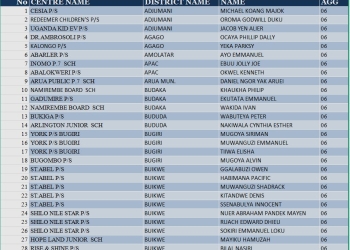
The language of instruction in the lower primary is emerging as a very critical subject before the Education Policy Review Commission (EPRC). Several individuals are expressing diverse opinions both in favor of and against the issue.
In one of the last public hearings of the commission, the Acholi parliamentary group joined the dissent against the current policy of using local language as a medium of instruction. They urged the commission to reconsider or even discard the policy, citing its ineffectiveness and impracticality.
Anthony Akol, the chairperson of the Acholi Parliamentary Group, questioned the rationale behind selecting some local languages to be used as others are not considered.
Akol emphasized that the policy is causing division, as different communities vie for their language to be the instructional medium.
According to Akol, learners excel when instructed in English, viewing the policy as widening the educational quality gap between the poor and rich, rural and urban areas. To emphasize his point, he challenged commission members to enroll their grandchildren in a school using a local language as the medium of instruction.
In 1989, the Kajubi report recommended that children should be instructed in their mother tongue and later on in 1992 government adapted it emphasizing the use of local area language during instruction for children to transition smoothly from home to formal education.
In 2007, the policy was implemented alongside a thematic curriculum that introduced local languages as the primary medium of instruction for primary one to three students. English was initially taught as a subject and later became the medium of instruction from primary four onward.
The curriculum aimed to develop basic literacy, math concepts, life skills, and values in a familiar language, preparing children for advanced learning. The goal was also to acquire enough English skills as a foundation for instruction in the Upper Primary Cycle while fostering an appreciation for their culture and understanding of societal roles.
Dr. Kedrace Turyagyenda, a former director of education standards at the education ministry and a commissioner at the EPRC, opposes the MPs’ suggestion to discard the policy. She argues that many critics hold misconceptions and some completely misunderstand the policy.
Dr. Turyagyenda emphasizes that the policy is not centered on teaching in the mother tongue of every learner but rather in the local language widely used in a specific area.
“The language choice should be based on what children commonly use to communicate with each other during their free time or in the community. Even in areas with multiple tribes, there tends to be a common language. If English meets this criterion, it is acceptable. In situations where selecting a dominant local language is challenging, especially in urban schools, using English as the medium of instruction is recommended,” Turyagyenda said.
Dr Mary Goretti Nakabugo, the Executive Director of Uwezo Uganda, says that research globally supports the idea that learners benefit from starting with their local language.
She contends that there is no room for debate as it is well-documented that a child in the early years learns and understands better when instructed in a familiar language.
However, she acknowledges that in Uganda’s context, certain factors were overlooked before implementing the policy. According to her, the current limitations in the Ugandan system have led to confusion regarding what works better and how to effectively implement it.
Dr Godfrey Siu, a senior lecturer in the Department of Child Health and Development at Makerere University, also supports the idea of instructing learners in lower classes using their local language. To him, at times viewing early learning as academic has unnecessarily complicated instruction at this level. In his view, children at this age should engage in learning through play and free interaction, best achieved using a language they are familiar with.
According to Dr. Siu, learning at these stages requires parental involvement, and parents can only effectively interact with learners in a language they are already familiar with. He emphasizes that learners should be taught in a language spoken or used at home, facilitating the extension of learning into the home environment.
As highlighted by Turyagyenda, Dr Nakabugo shares the perspective that using all languages in Uganda as mediums of instruction could be challenging. Instead, she suggests concentrating on widely spoken languages to avoid complications related to tribal considerations.
Nakabugo asserts that for successful implementation, the education ministry should pinpoint the most prevalent languages, allocate resources for its enhancement, and empower teachers.
“Numerous discussions on this issue are often viewed through tribal perspectives. While acknowledging that these viewpoints may be valid, the reality is that accommodating and addressing all languages and dialects would be an immensely challenging task,” she added.
According to her, research done by Uwezo points to the fact that the policy seems to yield more positive outcomes in central and western regions where languages are well-established. In contrast, areas like Busoga pose challenges, with teachers reportedly grappling with language difficulties.
In Uganda, English serves as the dominant language for formal communication in education, the judiciary, politics, and government. Luganda and Swahili are widely used as inter-ethnic communication languages across the country.
Despite having at least 43 living languages, five, including Luganda, Lwo, Runyakitara, Ateso, and Lugubara, were initially selected for use as mediums of instruction in the policy due to their widespread usage and prepared orthographies.
Over time, other regions, like Busoga, have also adopted their local languages for instruction. However, some experts argue that the abundance of local languages poses a significant challenge to education policies that prioritize the use of the mother tongue as the language of instruction in the early years.
A 2021 policy belief by Tusome Africa emphasizes that establishing a robust foundation in the first language proves more advantageous for second language learning than early or prolonged exposure to the additional language. Studies indicate that prioritizing the development of the first language is more efficient, as the acquired skills and concepts can be seamlessly transferred to the second language.
“The use of learners’ native languages in the classroom facilitates a smooth transition between home and school. It means that learners are more engaged in the learning process and that the development of basic literacy skills is accelerated,” reads the brief listing of eight reasons supporting the use of local language at lower stages of learning.
However, Dr. Siu felt compelled to explore the other perspective, contending that despite the well-intentioned approach of instructing learners in local languages, the current lack of capacity in Uganda may suggest that the policy should have been delayed. He underscores that there was a need to address existing challenges before fully implementing the policy.
USAID’s 2020 Language of Instruction Country Profile for Uganda underscores notable challenges in implementing the mother tongue language policy, starting with the inadequate proficiency of teachers in local languages.
The profile points out that in a survey of 95 new primary school teachers in Uganda, 68% expressed confidence in teaching reading exclusively in English. This highlights a significant challenge, as many teachers lack formal training in the specific local language designated for instructional use.
In Namayumba, Wakiso district, a government school teacher who preferred anonymity shared that attempts to implement the policy of teaching in a local language faced resistance from parents who insisted on English as the medium of instruction for their children.
“I’ll be straightforward; we understand that teaching in the local language at this level is optimal. but parents associate English with quality education. For them, instructing their learners in Luganda is perceived as negative, and they explicitly use the term ‘kukonya,'” the teacher shared.
Isaac Mukasa, a parent of three in Masaka district, supported the teacher’s perspective. He vehemently opposes the policy of teaching in Luganda, contending that it is a sign of a subpar school if they instruct primary learners in the local language.
Mukasa argued, “Look around and see. Better-performing schools start teaching in English from nursery. In our area, we have government schools like Hill Road that teach in English and consistently perform well, whereas those performing poorly are the ones teaching in Luganda.”
While this is using local language as a medium of instruction is a national concern, private schools both rural and urban private schools seem to have rejected it. Dr Nakabugo emphasizes that private schools are primarily motivated by demand and results, aligning their approach with parental preferences and assessments. To attract more students, proficiency in English becomes a significant factor for these schools.
Dr. Siu observes that this issue is not isolated, as many policies appear to be implemented primarily in selected public schools, predominantly in rural areas. In his view, the narrative is the most significant problem, placing a substantial burden on the commission to find solutions to this aspect as well.
Some teachers who opposed the idea of teaching in local languages pointed out that these languages may have limited utility in teaching, particularly in subjects like science.
They believed that local languages were more suitable for social situations and should be restricted to such contexts. This sentiment was echoed by Akol during his appearance before the commission. He cited the example of colors, highlighting that some colors lack equivalent words in local languages, yet learners are required to understand them.
However, Dr Turyagenda dismissed this concern, emphasizing that at the primary one and three levels, there are no complex science concepts that teachers need to cover. In her view, learning at this stage should be rooted in the familiar, drawing from the local environment to prepare the learner.
Many African nations adopt local languages for lower-grade instruction. In Kenya, urban schools teach Grades 1 to 3 in English or Kiswahili; rural areas use the learners’ mother tongue. Grade 4 onwards, all learn in English. South Africa, with 11 languages, uses local languages for Grades 1 to 3.
English is introduced in Grades 1 and 2, becoming the language of instruction in Grade 4. According to their language policy, learners choose during admission, and if a school uses that language and has space, they must admit the learner.
URN

















